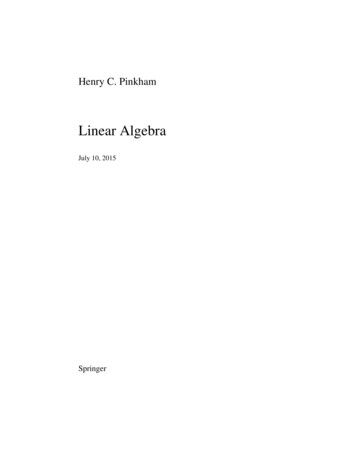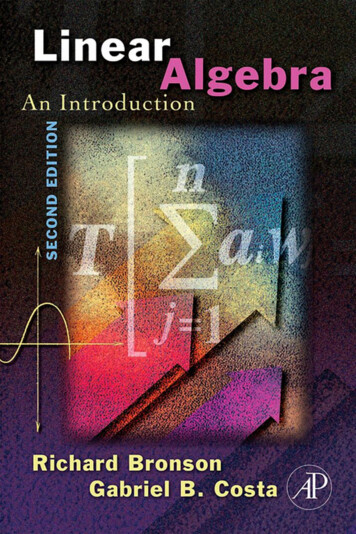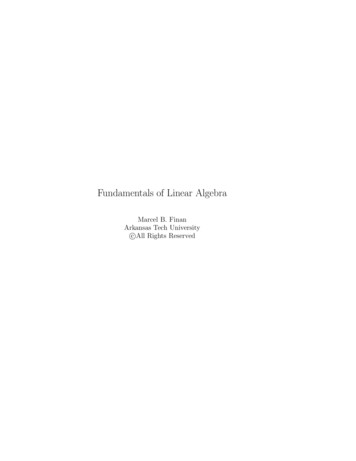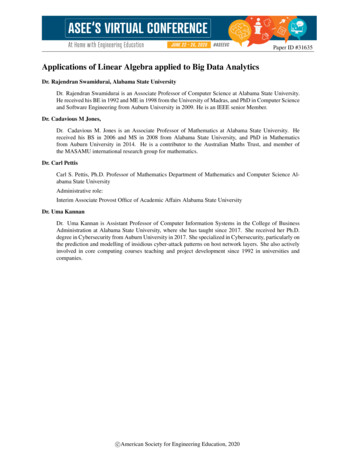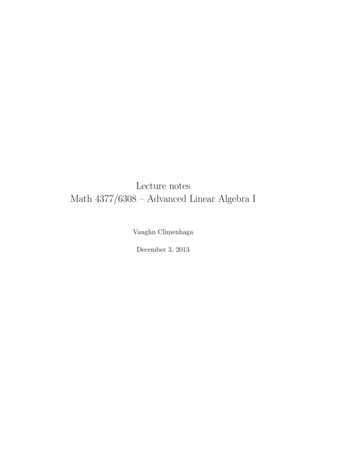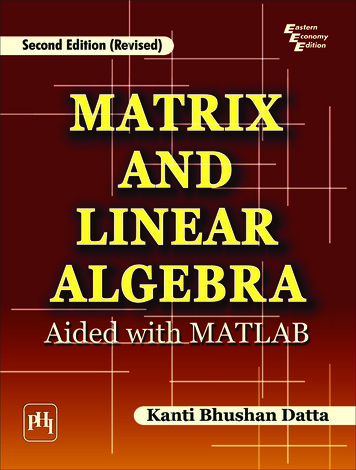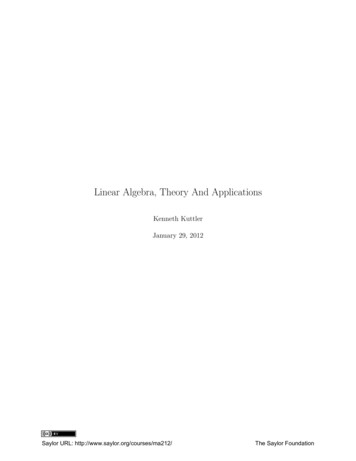
Transcription
Linear Algebra, Theory And ApplicationsKenneth KuttlerJanuary 29, 2012Saylor URL: http://www.saylor.org/courses/ma212/The Saylor Foundation
2Linear Algebra, Theory and Applications was written by Dr. Kenneth Kuttler of Brigham Young University forteaching Linear Algebra II. After The Saylor Foundation accepted his submission to Wave I of the OpenTextbook Challenge, this textbook was relicensed as CC-BY 3.0.Information on The Saylor Foundation’s Open Textbook Challenge can be found at www.saylor.org/otc/.Linear Algebra, Theory, and Applications January 29, 2012 by Kenneth Kuttler, is licensed under a CreativeCommons Attribution (CC BY) license made possible by funding from The Saylor Foundation's OpenTextbook Challenge in order to be incorporated into Saylor.org's collection of open courses available at: http://www.saylor.org" Full license terms may be viewed at: deSaylor URL: http://www.saylor.org/courses/ma212/The Saylor Foundation
Contents1 Preliminaries1.1 Sets And Set Notation . . . . . . . . . . . . . . . . . .1.2 Functions . . . . . . . . . . . . . . . . . . . . . . . . .1.3 The Number Line And Algebra Of The Real Numbers1.4 Ordered fields . . . . . . . . . . . . . . . . . . . . . . .1.5 The Complex Numbers . . . . . . . . . . . . . . . . . .1.6 Exercises . . . . . . . . . . . . . . . . . . . . . . . . .1.7 Completeness of R . . . . . . . . . . . . . . . . . . . .1.8 Well Ordering And Archimedean Property . . . . . . .1.9 Division And Numbers . . . . . . . . . . . . . . . . . .1.10 Systems Of Equations . . . . . . . . . . . . . . . . . .1.11 Exercises . . . . . . . . . . . . . . . . . . . . . . . . .1.12 Fn . . . . . . . . . . . . . . . . . . . . . . . . . . . . .1.13 Algebra in Fn . . . . . . . . . . . . . . . . . . . . . . .1.14 Exercises . . . . . . . . . . . . . . . . . . . . . . . . .1.15 The Inner Product In Fn . . . . . . . . . . . . . . . .1.16 What Is Linear Algebra? . . . . . . . . . . . . . . . . .1.17 Exercises . . . . . . . . . . . . . . . . . . . . . . . . .1111121214151920212326313232333336362 Matrices And Linear Transformations2.1 Matrices . . . . . . . . . . . . . . . . . . . . . . . . . . . .2.1.1 The ij th Entry Of A Product . . . . . . . . . . . .2.1.2 Digraphs . . . . . . . . . . . . . . . . . . . . . . .2.1.3 Properties Of Matrix Multiplication . . . . . . . .2.1.4 Finding The Inverse Of A Matrix . . . . . . . . . .2.2 Exercises . . . . . . . . . . . . . . . . . . . . . . . . . . .2.3 Linear Transformations . . . . . . . . . . . . . . . . . . .2.4 Subspaces And Spans . . . . . . . . . . . . . . . . . . . .2.5 An Application To Matrices . . . . . . . . . . . . . . . . .2.6 Matrices And Calculus . . . . . . . . . . . . . . . . . . . .2.6.1 The Coriolis Acceleration . . . . . . . . . . . . . .2.6.2 The Coriolis Acceleration On The Rotating Earth2.7 Exercises . . . . . . . . . . . . . . . . . . . . . . . . . . .37374143454851535661626366713 Determinants3.1 Basic Techniques And Properties . . . . . .3.2 Exercises . . . . . . . . . . . . . . . . . . .3.3 The Mathematical Theory Of Determinants3.3.1 The Function sgn . . . . . . . . . . .7777818384.3Saylor URL: http://www.saylor.org/courses/ma212/The Saylor Foundation
4CONTENTS3.43.53.63.3.2 The Definition Of The Determinant .3.3.3 A Symmetric Definition . . . . . . . .3.3.4 Basic Properties Of The Determinant3.3.5 Expansion Using Cofactors . . . . . .3.3.6 A Formula For The Inverse . . . . . .3.3.7 Rank Of A Matrix . . . . . . . . . . .3.3.8 Summary Of Determinants . . . . . .The Cayley Hamilton Theorem . . . . . . . .Block Multiplication Of Matrices . . . . . . .Exercises . . . . . . . . . . . . . . . . . . . .4 Row Operations4.1 Elementary Matrices . . . . . . .4.2 The Rank Of A Matrix . . . . .4.3 The Row Reduced Echelon Form4.4 Rank And Existence Of Solutions4.5 Fredholm Alternative . . . . . . .4.6 Exercises . . . . . . . . . . . . . . . .To. . . . . . . . . . . .Linear. . . . . . .868788909294969798102. . . . . . . . . . . . .Systems. . . . . . . . .1051051101121161171185 Some Factorizations5.1 LU Factorization . . . . . . . . . . . . . . . . . . .5.2 Finding An LU Factorization . . . . . . . . . . . .5.3 Solving Linear Systems Using An LU Factorization5.4 The P LU Factorization . . . . . . . . . . . . . . .5.5 Justification For The Multiplier Method . . . . . .5.6 Existence For The P LU Factorization . . . . . . .5.7 The QR Factorization . . . . . . . . . . . . . . . .5.8 Exercises . . . . . . . . . . . . . . . . . . . . . . .1231231231251261271281301336 Linear Programming6.1 Simple Geometric Considerations .6.2 The Simplex Tableau . . . . . . . .6.3 The Simplex Algorithm . . . . . .6.3.1 Maximums . . . . . . . . .6.3.2 Minimums . . . . . . . . . .6.4 Finding A Basic Feasible Solution .6.5 Duality . . . . . . . . . . . . . . .6.6 Exercises . . . . . . . . . . . . . .1351351361401401431501521567 Spectral Theory7.1 Eigenvalues And Eigenvectors Of A Matrix . . . . .7.2 Some Applications Of Eigenvalues And Eigenvectors7.3 Exercises . . . . . . . . . . . . . . . . . . . . . . . .7.4 Schur’s Theorem . . . . . . . . . . . . . . . . . . . .7.5 Trace And Determinant . . . . . . . . . . . . . . . .7.6 Quadratic Forms . . . . . . . . . . . . . . . . . . . .7.7 Second Derivative Test . . . . . . . . . . . . . . . . .7.8 The Estimation Of Eigenvalues . . . . . . . . . . . .7.9 Advanced Theorems . . . . . . . . . . . . . . . . . .7.10 Exercises . . . . . . . . . . . . . . . . . . . . . . . .157157164167173180181182186187190Saylor URL: http://www.saylor.org/courses/ma212/.The Saylor Foundation
CONTENTS58 Vector Spaces And Fields8.1 Vector Space Axioms . . . . . . . . . . . . . .8.2 Subspaces And Bases . . . . . . . . . . . . . .8.2.1 Basic Definitions . . . . . . . . . . . .8.2.2 A Fundamental Theorem . . . . . . .8.2.3 The Basis Of A Subspace . . . . . . .8.3 Lots Of Fields . . . . . . . . . . . . . . . . . .8.3.1 Irreducible Polynomials . . . . . . . .8.3.2 Polynomials And Fields . . . . . . . .8.3.3 The Algebraic Numbers . . . . . . . .8.3.4 The Lindemannn Weierstrass Theorem8.4 Exercises . . . . . . . . . . . . . . . . . . . . . . . . . . . . . . . . . . . . . .And. . . . . . . . . . . . . . . . . . . . . . . . . . . . . .Vector. . . . . . . . . . . . . . . . . . . . . . . . . . . . . . . . . . . . . . . .Spaces . . . . .1991992002002012052052052102152192199 Linear Transformations9.1 Matrix Multiplication As A Linear Transformation . . . . .9.2 L (V, W ) As A Vector Space . . . . . . . . . . . . . . . . . .9.3 The Matrix Of A Linear Transformation . . . . . . . . . . .9.3.1 Some Geometrically Defined Linear Transformations9.3.2 Rotations About A Given Vector . . . . . . . . . . .9.3.3 The Euler Angles . . . . . . . . . . . . . . . . . . . .9.4 Eigenvalues And Eigenvectors Of Linear Transformations .9.5 Exercises . . . . . . . . . . . . . . . . . . . . . . . . . . . .22522522522723423723824024210 Linear Transformations Canonical Forms10.1 A Theorem Of Sylvester, Direct Sums . .10.2 Direct Sums, Block Diagonal Matrices . .10.3 Cyclic Sets . . . . . . . . . . . . . . . . .10.4 Nilpotent Transformations . . . . . . . . .10.5 The Jordan Canonical Form . . . . . . . .10.6 Exercises . . . . . . . . . . . . . . . . . .10.7 The Rational Canonical Form . . . . . . .10.8 Uniqueness . . . . . . . . . . . . . . . . .10.9 Exercises . . . . . . . . . . . . . . . . . .24524524825125525726226626927311 Markov Chains And Migration Processes11.1 Regular Markov Matrices . . . . . . . . .11.2 Migration Matrices . . . . . . . . . . . . .11.3 Markov Chains . . . . . . . . . . . . . . .11.4 Exercises . . . . . . . . . . . . . . . . . .27527527927928412 Inner Product Spaces12.1 General Theory . . . . . . . . . . . .12.2 The Gram Schmidt Process . . . . .12.3 Riesz Representation Theorem . . .12.4 The Tensor Product Of Two Vectors12.5 Least Squares . . . . . . . . . . . . .12.6 Fredholm Alternative Again . . . . .12.7 Exercises . . . . . . . . . . . . . . .12.8 The Determinant And Volume . . .12.9 Exercises . . . . . . . . . . . . . . .287287289292295296298298303306Saylor URL: http://www.saylor.org/courses/ma212/.The Saylor Foundation
6CONTENTS13 Self Adjoint Operators13.1 Simultaneous Diagonalization . . . . . . . . . . .13.2 Schur’s Theorem . . . . . . . . . . . . . . . . . .13.3 Spectral Theory Of Self Adjoint Operators . . . .13.4 Positive And Negative Linear Transformations .13.5 Fractional Powers . . . . . . . . . . . . . . . . . .13.6 Polar Decompositions . . . . . . . . . . . . . . .13.7 An Application To Statistics . . . . . . . . . . .13.8 The Singular Value Decomposition . . . . . . . .13.9 Approximation In The Frobenius Norm . . . . .13.10Least Squares And Singular Value Decomposition13.11The Moore Penrose Inverse . . . . . . . . . . . .13.12Exercises . . . . . . . . . . . . . . . . . . . . . .30730731031231731932232532732933133133414 Norms For Finite Dimensional Vector Spaces14.1 The p Norms . . . . . . . . . . . . . . . . . . .14.2 The Condition Number . . . . . . . . . . . . .14.3 The Spectral Radius . . . . . . . . . . . . . . .14.4 Series And Sequences Of Linear Operators . . .14.5 Iterative Methods For Linear Systems . . . . .14.6 Theory Of Convergence . . . . . . . . . . . . .14.7 Exercises . . . . . . . . . . . . . . . . . . . . .33734334534835035436036315 Numerical Methods For Finding Eigenvalues15.1 The Power Method For Eigenvalues . . . . . . . . . . . . .15.1.1 The Shifted Inverse Power Method . . . . . . . . .15.1.2 The Explicit Description Of The Method . . . . .15.1.3 Complex Eigenvalues . . . . . . . . . . . . . . . . .15.1.4 Rayleigh Quotients And Estimates for Eigenvalues15.2 The QR Algorithm . . . . . . . . . . . . . . . . . . . . . .15.2.1 Basic Properties And Definition . . . . . . . . . .15.2.2 The Case Of Real Eigenvalues . . . . . . . . . . .15.2.3 The QR Algorithm In The General Case . . . . . .15.3 Exercises . . . . . . . . . . . . . . . . . . . . . . . . . . .371371375376381383386386390394401.A Positive Matrices403B Functions Of Matrices411C Applications To Differential EquationsC.1 Theory Of Ordinary Differential EquationsC.2 Linear Systems . . . . . . . . . . . . . . . .C.3 Local Solutions . . . . . . . . . . . . . . . .C.4 First Order Linear Systems . . . . . . . . .C.5 Geometric Theory Of Autonomous SystemsC.6 General Geometric Theory . . . . . . . . . .C.7 The Stable Manifold . . . . . . . . . . . . .417417418419421428432434D Compactness And Completeness439D.0.1 The Nested Interval Lemma . . . . . . . . . . . . . . . . . . . . . . . . 439D.0.2 Convergent Sequences, Sequential Compactness . . . . . . . . . . . . . 440Saylor URL: http://www.saylor.org/courses/ma212/The Saylor Foundation
CONTENTS7E The Fundamental Theorem Of Algebra443F Fields And Field ExtensionsF.1 The Symmetric Polynomial Theorem . . . .F.2 The Fundamental Theorem Of Algebra . . .F.3 Transcendental Numbers . . . . . . . . . . .F.4 More On Algebraic Field Extensions . . . .F.5 The Galois Group . . . . . . . . . . . . . .F.6 Normal Subgroups . . . . . . . . . . . . . .F.7 Normal Extensions And Normal SubgroupsF.8 Conditions For Separability . . . . . . . . .F.9 Permutations . . . . . . . . . . . . . . . . .F.10 Solvable Groups . . . . . . . . . . . . . . .F.11 Solvability By Radicals . . . . . . . . . . . .G Answers To Selected ExercisesG.1 Exercises . . . . . . . . . . .G.2 Exercises . . . . . . . . . . .G.3 Exercises . . . . . . . . . . .G.4 Exercises . . . . . . . . . . .G.5 Exercises . . . . . . . . . . .G.6 Exercises . . . . . . . . . . .G.7 Exercises . . . . . . . . . . .G.8 Exercises . . . . . . . . . . .G.9 Exercises . . . . . . . . . . .G.10 Exercises . . . . . . . . . . .G.11 Exercises . . . . . . . . . . .G.12 Exercises . . . . . . . . . . .G.13 Exercises . . . . . . . . . . .G.14 Exercises . . . . . . . . . . .G.15 Exercises . . . . . . . . . . .G.16 Exercises . . . . . . . . . . .G.17 Exercises . . . . . . . . . . .G.18 Exercises . . . . . . . . . . .G.19 Exercises . . . . . . . . . . .G.20 Exercises . . . . . . . . . . .G.21 Exercises . . . . . . . . . . .G.22 Exercises . . . . . . . . . . .G.23 Exercises . . . . . . . . . . .c 2012,Copyright ⃝.Saylor URL: 9490491492492493494494494495495495496496496496The Saylor Foundation
8Saylor URL: http://www.saylor.org/courses/ma212/CONTENTSThe Saylor Foundation
PrefaceThis is a book on linear algebra and matrix theory. While it is self contained, it will workbest for those who have already had some exposure to linear algebra. It is also assumed thatthe reader has had calculus. Some optional topics require more analysis than this, however.I think that the subject of linear algebra is likely the most significant topic discussed inundergraduate mathematics courses. Part of the reason for this is its usefulness in unifyingso many different topics. Linear algebra is essential in analysis, applied math, and even intheoretical mathematics. This is the point of view of this book, more than a presentationof linear algebra for its own sake. This is why there are numerous applications, some fairlyunusual.This book features an ugly, elementary, and complete treatment of determinants earlyin the book. Thus it might be considered as Linear algebra done wrong. I have done thisbecause of the usefulness of determinants. However, all major topics are also presented inan alternative manner which is independent of determinants.The book has an introduction to various numerical methods used in linear algebra.This is done because of the interesting nature of these methods. The presentation hereemphasizes the reasons why they work. It does not discuss many important numericalconsiderations necessary to use the methods effectively. These considerations are found innumerical analysis texts.In the exercises, you may occasionally see at the beginning. This means you ought tohave a look at the exercise above it. Some exercises develop a topic sequentially. There arealso a few exercises which appear more than once in the book. I have done this deliberatelybecause I think that these illustrate exceptionally important topics and because some peopledon’t read the whole book from start to finish but instead jump in to the middle somewhere.There is one on a theorem of Sylvester which appears no fewer than 3 times. Then it is alsoproved in the text. There are multiple proofs of the Cayley Hamilton theorem, some in theexercises. Some exercises also are included for the sake of emphasizing something which hasbeen done in the preceding chapter.9Saylor URL: http://www.saylor.org/courses/ma212/The Saylor Foundation
10Saylor URL: http://www.saylor.org/courses/ma212/CONTENTSThe Saylor Foundation
Preliminaries1.1Sets And Set NotationA set is just a collection of things called elements. For example {1, 2, 3, 8} would be a setconsisting of the elements 1,2,3, and 8. To indicate that 3 is an element of {1, 2, 3, 8} , it iscustomary to write 3 {1, 2, 3, 8} . 9 / {1, 2, 3, 8} means 9 is not an element of {1, 2, 3, 8} .Sometimes a rule specifies a set. For example you could specify a set as all integers largerthan 2. This would be written as S {x Z : x 2} . This notation says: the set of allintegers, x, such that x 2.If A and B are sets with the property that every element of A is an element of B, then A isa subset of B. For example, {1, 2, 3, 8} is a subset of {1, 2, 3, 4, 5, 8} , in symbols, {1, 2, 3, 8} {1, 2, 3, 4, 5, 8} . It is sometimes said that “A is contained in B” or even “B contains A”.The same statement about the two sets may also be written as {1, 2, 3, 4, 5, 8} {1, 2, 3, 8}.The union of two sets is the set consisting of everything which is an element of at leastone of the sets, A or B. As an example of the union of two sets {1, 2, 3, 8} {3, 4, 7, 8} {1, 2, 3, 4, 7, 8} because these numbers are those which are in at least one of the two sets. IngeneralA B {x : x A or x B} .Be sure you understand that something which is in both A and B is in the union. It is notan exclusive or.The intersection of two sets, A and B consists of everything which is in both of the sets.Thus {1, 2, 3, 8} {3, 4, 7, 8} {3, 8} because 3 and 8 are those elements the two sets havein common. In general,A B {x : x A and x B} .The symbol [a, b] where a and b are real numbers, denotes the set of real numbers x,such that a x b and [a, b) denotes the set of real numbers such that a x b. (a, b)consists of the set of real numbers x such that a x b and (a, b] indicates the set ofnumbers x such that a x b. [a, ) means the set of all numbers x such that x a and( , a] means the set of all real numbers which are less than or equal to a. These sorts ofsets of real numbers are called intervals. The two points a and b are called endpoints of theinterval. Other intervals such as ( , b) are defined by analogy to what was just explained.In general, the curved parenthesis indicates the end point it sits next to is not includedwhile the square parenthesis indicates this end point is included. The reason that therewill always be a curved parenthesis next to or is that these are not real numbers.Therefore, they cannot be included in any set of real numbers.A special set which needs to be given a name is the empty set also called the null set,denoted by . Thus is defined as the set which has no elements in it. Mathematicians liketo say the empty set is a subset of every set. The reason they say this is that if it were not11Saylor URL: http://www.saylor.org/courses/ma212/The Saylor Foundation
12PRELIMINARIESso, there would have to exist a set A, such that has something in it which is not in A.However, has nothing in it and so the least intellectual discomfort is achieved by saying A.If A and B are two sets, A \ B denotes the set of things which are in A but not in B.ThusA \ B {x A : x / B} .Set notation is used whenever convenient.1.2FunctionsThe concept of a function is that of something which gives a unique output for a given input.Definition 1.2.1 Consider two sets, D and R along with a rule which assigns a uniqueelement of R to every element of D. This rule is called a function and it is denoted by aletter such as f. Given x D, f (x) is the name of the thing in R which results from doingf to x. Then D is called the domain of f. In order to specify that D pertains to f , thenotation D (f ) may be used. The set R is sometimes called the range of f. These days itis referred to as the codomain. The set of all elements of R which are of the form f (x)for some x D is therefore, a subset of R. This is sometimes referred to as the image off . When this set equals R, the function f is said to be onto, also surjective. If wheneverx ̸ y it follows f (x) ̸ f (y), the function is called one to one. , also injective It iscommon notation to write f : D 7 R to denote the situation just described in this definitionwhere f is a function defined on a domain D which has values in a codomain R. Sometimesfyou may also see something like D 7 R to denote the same thing.1.3The Number Line And Algebra Of The Real NumbersNext, consider the real numbers, denoted by R, as a line extending infinitely far in bothdirections. In this book, the notation, indicates something is being defined. Thus theintegers are defined asZ {· · · 1, 0, 1, · · · } ,the natural numbers,N {1, 2, · · · }and the rational numbers, defined as the numbers which are the quotient of two integers.{m}Q such that m, n Z, n ̸ 0nare each subsets of R as indicated in the following picture. 4 3 2 101234-1/2As shown in the picture, 21 is half way between the number 0 and the number, 1. Byanalogy, you can see where to place all the other rational numbers. It is assumed that R hasSaylor URL: http://www.saylor.org/courses/ma212/The Saylor Foundation
1.3. THE NUMBER LINE AND ALGEBRA OF THE REAL NUMBERS13the following algebra properties, listed here as a collection of assertions called axioms. Theseproperties will not be proved which is why they are called axioms rather than theorems. Ingeneral, axioms are statements which are regarded as true. Often these are things whichare “self evident” either from experience or from some sort of intuition but this does nothave to be the case.Axiom 1.3.1 x y y x, (commutative law for addition)Axiom 1.3.2 x 0 x, (additive identity).Axiom 1.3.3 For each x R, there exists x R such that x ( x) 0, (existence ofadditive inverse).Axiom 1.3.4 (x y) z x (y z) , (associative law for addition).Axiom 1.3.5 xy yx, (commutative law for multiplication).Axiom 1.3.6 (xy) z x (yz) , (associative law for multiplication).Axiom 1.3.7 1x x, (multiplicative identity).Axiom 1.3.8 For each x ̸ 0, there exists x 1 such that xx 1 1.(existence of multiplicative inverse).Axiom 1.3.9 x (y z) xy xz.(distributive law).These axioms are known as the field axioms and any set (there are many others besidesR) which has two such operations satisfying the above axioms is called a field.and( Division)subtraction are defined in the usual way by x y x ( y) and x/y x y 1 .Here is a little proposition which derives some familiar facts.Proposition 1.3.10 0 and 1 are unique. Also x is unique and x 1 is unique. Furthermore, 0x x0 0 and x ( 1) x.Proof: Suppose 0′ is another additive identity. Then0′ 0′ 0 0.Thus 0 is unique. Say 1′ is another multiplicative identity. Then1 1′ 1 1′ .Now suppose y acts like the additive inverse of x. Then x ( x) 0 ( x) (x y) ( x x) y yFinally,0x (0 0) x 0x 0xand so0 (0x) 0x (0x) (0x 0x) ( (0x) 0x) 0x 0xFinallyx ( 1) x (1 ( 1)) x 0x 0and so by uniqueness of the additive inverse, ( 1) x x. Saylor URL: http://www.saylor.org/courses/ma212/The Saylor Foundation
14PRELIMINARIES1.4Ordered fieldsThe real numbers R are an example of an ordered field. More generally, here is a definition.Definition 1.4.1 Let F be a field. It is an ordered field if there exists an order, whichsatisfies1. For any x ̸ y, either x y or y x.2. If x y and either z w or z w, then, x z y w.3. If 0 x, 0 y, then xy 0.With this definition, the familiar properties of order can be proved. The followingproposition lists many of these familiar properties. The relation ‘a b’ has the samemeaning as ‘b a’.Proposition 1.4.2 The following are obtained.1. If x y and y z, then x z.2. If x 0 and y 0, then x y 0.3. If x 0, then x 0.4. If x ̸ 0, either x or x is 0.5. If x y, then x y.6. If x ̸ 0, then x2 0.7. If 0 x y then x 1 y 1 .Proof: First consider 1, called the transitive law. Suppose that x y and y z. Thenfrom the axioms, x y y z and so, adding y to both sides, it followsx zNext consider 2. Suppose x 0 and y 0. Then from 2,0 0 0 x y.Next consider 3. It is assumed x 0 so0 x x 0 ( x) xNow consider 4. If x 0, then0 x ( x) 0 ( x) x.Consider the 5. Since x y, it follows from 20 x ( x) y ( x)and so by 4 and Proposition 1.3.10,( 1) (y ( x)) 0Saylor URL: http://www.saylor.org/courses/ma212/The Saylor Foundation
1.5. THE COMPLEX NUMBERS15Also from Proposition 1.3.10 ( 1) ( x) ( x) x and so y x 0.Hence y x.Consider 6. If x 0, there is nothing to show. It follows from the definition. If x 0,then by 4, x 0 and so by Proposition 1.3.10 and the definition of the order,2( x) ( 1) ( 1) x2 0By this proposition again, ( 1) ( 1) ( 1) 1 and so x2 0 as claimed. Note that1 0 because it equals 12 .Finally, consider 7. First, if x 0 then if x 1 0, it would follow ( 1) x 1 0 and sox ( 1) x 1 ( 1) 1 1 0. However, this would require0 1 12 0from what was just shown. Therefore, x 1 0. Now the assumption implies y ( 1) x 0and so multiplying by x 1 ,yx 1 ( 1) xx 1 yx 1 ( 1) 0Now multiply by y 1 , which by the above satisfies y 1 0, to obtainx 1 ( 1) y 1 0and sox 1 y 1 . In an ordered field the symbols and have the usual meanings. Thus a b meansa b or else a b, etc.1.5The Complex NumbersJust as a real number should be considered as a point on the line, a complex number isconsidered a point in the plane which can be identified in the usual way using the Cartesiancoordinates of the point. Thus (a, b) identifies a point whose x coordinate is a and whosey coordinate is b. In dealing with complex numbers, such a point is written as a ib andmultiplication and addition are defined in the most obvious way subject to the conventionthat i2 1. Thus,(a ib) (c id) (a c) i (b d)and(a ib) (c id) ac iad ibc i2 bd (ac bd) i (bc ad) .Every non zero complex number, a ib, with a2 b2 ̸ 0, has a unique multiplicative inverse.1a ibab 2 2 i 2.a iba b2a b2a b2You should prove the following theorem.Saylor URL: http://www.saylor.org/courses/ma212/The Saylor Foundation
16PRELIMINARIESTheorem 1.5.1 The complex numbers with multiplication and addition defined as aboveform a field satisfying all the field axioms listed on Page 13.Note that if x iy is a complex number, it can be written as() xy22 x iy x y i x2 y 2x2 y 2()yxNow 2 2 , 2 2 is a point on the unit circle and so there exists a unique θ [0, 2π)x yx y such that this ordered pair equals (cos θ, sin θ) . Letting r x2 y 2 , it follows that thecomplex number can be written in the formx iy r (cos θ i sin θ)This is called the polar form of the complex number.The field of complex numbers is denoted as C. An important construction regardingcomplex numbers is the complex conjugate denoted by a horizontal line above the number.It is defined as follows.a ib a ib.What it does is reflect a given complex number across the x axis. Algebraically, the followingformula is easy to obtain.()a ib (a ib) a2 b2 .Definition 1.5.2 Define the absolute value of a complex number as follows. a ib a2 b2 .Thus, denoting by z the complex number, z a ib, z (zz)1/2.With this definition, it is important to note the following. Be sure to verify this. It isnot too hard but you need to do it. 22Remark 1.5.3 : Let z a ib and w c id. Then z w (a c) (b d) . Thusthe distance between the point in the plane determined by the ordered pair, (a, b) and theordered pair (c, d) equals z w where z and w are as just described.For example, considerthe distance between (2, 5) and (1, 8) . From the distance formula 22this distance equals (2 1) (5 8) 10. On the other hand, letting z 2 i5 and w 1 i8, z w 1 i3 and so (z w) (z w) (1 i3) (1 i3)
Linear algebra is essential in analysis, applied math, and even in theoretical mathematics. This is the point of view of this book, more than a presentation of linear algebra for its own sake. This is
